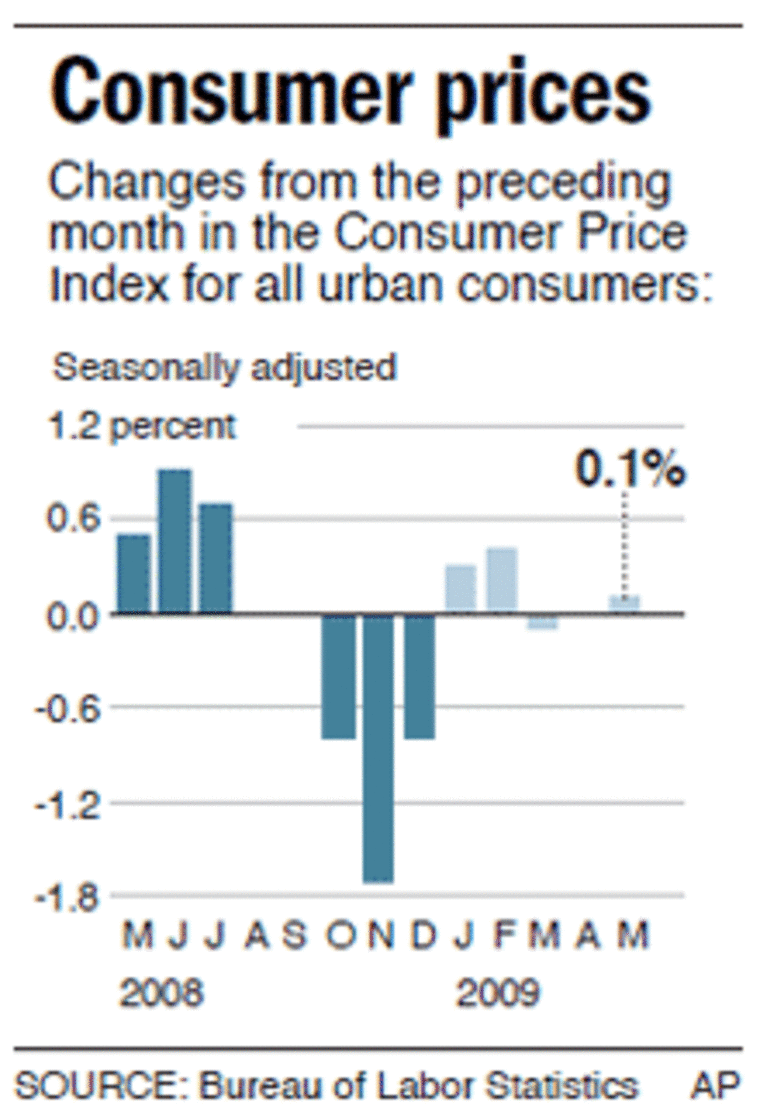Consumer prices rose less than expected in May and posted the steepest annual drop in 59 years, according to government data released Wednesday, fresh evidence that the recession is keeping inflation in check.
Low prices will make it easier for the Federal Reserve at its meeting next week to keep a key short-term interest rate near zero, where it has been since December. Bond yields ticked up earlier this month on concerns that signs of an improving economy would force the Fed to raise rates later this year.
But most economists consider a rate increase unlikely until next year.
Still, as higher government spending pushes this year's deficit toward a record of nearly $1.85 trillion, many economists warn that inflation could be a threat in two to three years.
"Inflation may be coming, but it's not here yet and likely won't be for some time," Richard Moody, chief economist at Forward Capital, wrote in a note to clients.
The Labor Department reported that the consumer price index rose a seasonally adjusted 0.1 percent last month, below analysts' expectations of a 0.3 percent rise.
Excluding volatile food and energy costs, core prices also increased 0.1 percent, matching expectations.
The recession is holding down prices as the unemployment rate has reached a 25-year high and factories are operating at record-low levels. Workers concerned about their jobs are less likely to push for higher pay, while low consumer demand has made it difficult for companies to raise prices.
Separately, the Commerce Department said Wednesday the current account trade deficit dropped to $101.5 billion in the first quarter, down 34.5 percent from the fourth quarter. It was the lowest current account deficit since the final quarter of 2001 when the country was mired in the last recession.

The financial markets edged up in afternoon trading after an early slide, partly due to a weaker-than-expected profit forecast by FedEx Corp. The Dow Jones industrial average added about 40 points, and broader indices also gained.
Gasoline prices rose 9.6 percent in May, before seasonal adjustment, the department said. But they are still much lower than last year, when prices at the pump topped $4 a gallon during the summer.
Due to that decline, consumer prices fell 1.3 percent in the 12 months ending in May, the steepest drop since 1950. The core CPI has increased 1.8 percent since last year.
Food prices in the U.S. fell for the fourth straight month in May, the department said, as costs fell for all six of the major grocery food groups, including fruits and vegetables, meats and poultry, and dairy products.
Tobacco prices fell 0.3 percent after two months of large increases. Cigarette makers increased prices in the spring ahead of a steep tax increase.
Consumers, hammered by job losses, declining home values and dwindling stock portfolios, are increasingly frugal. That has forced some retailers to cut prices.
Electronics retailer Best Buy Co. Inc. said Tuesday that its sales of flat-screen TVs were flat in the first quarter, compared with the previous year, as it sold more units at lower prices.
The Richfield, Minn.-based company said its profits dropped 15 percent in the January-March period, even as its rival Circuit City was liquidated and left the market.
The Producer Price Index, which measures price pressures before they reach consumers, rose a seasonally adjusted 0.2 percent from April, the department said Tuesday. That was below analysts' expectations of a 0.6 percent rise.
Despite the increase, wholesale prices fell 5 percent over the past 12 months. That was the largest annual drop in nearly 60 years. Excluding volatile food and energy prices, the core PPI dropped 0.1 percent in May, also below analysts' forecasts.
Falling prices can raise fears about deflation, a destabilizing period of extended declines. Lower prices may seem like a good thing, but deflation can cause consumers to postpone purchases, leading to drops in production and wage cuts.
But most analysts say efforts by the Fed to stimulate the economy will prevent that from occurring.
Besides lowering its benchmark interest rate to record lows, the Fed has taken other measures to flood the banking system with cash to counter a severe credit crisis.
There are concerns about deflation in other parts of the world, especially in Japan, where prices have been falling. That country underwent a destabilizing bout of deflation during the 1990s, when the world's second largest economy struggled to emerge from a real estate and banking crisis.
Price declines also have been registered in China and India.
A group of economists from the nation's largest banks predicted Tuesday that prices will continue to fall this year. The American Bankers Association's Economic Advisory Committee projects that core consumer prices will decline at a 1 percent annual rate by the end of 2009.
But Bruce Kasman, chief economist for JPMorgan Chase & Co. and chairman of the committee, said inflation is a greater risk than deflation over the next several years, due to the expected huge budget deficits.
Many economists don't expect the Fed to raise interest rates until the unemployment rate stops rising. It rose to a 25-year high of 9.4 percent in May and many forecasters believe the jobless rate will top 10 percent by year's end.